Impact Of Information System Strategy On Organizational Performance
Question
Task:
In this assessment students are required to write a report on a topic, given below. These topics are
related to IS strategy, Management, Organization and Technology. Choose a topic from the list below
please:
1. The IS strategies and evidences for gaining competitive advantage through technology and
acquisition
OR
2. The impact of artificial intelligence on decision support system.
OR
3. The impact of IS strategy on organizational performance.
Students are advised to do their own research on the topic selected, and make a report which will
cover the followings
• Introduction
• Discussion of the core concepts
• Critical analysis of the impact of it (i.e. strategies/artificial intelligence/IS strategy)
on (acquisition/decision support/organizational performance)
• Examples and evidences to support the arguments
• Conclusion
Answer
Introduction
The current study is focused on exploring the impact of information system strategy on the organizational performance in a detailed manner. The world is dynamic; it is changing with each passing day and the preferences and needs of the customers are also changing. The companies need to track their innovation and continuously bring progress in their products for market benefits. By bringing new business processes and implementing new products, the companies are trying to remain at a competitive advantage. In the present day, any organisation success directly depends upon the information system strategy. Good and efficient information system helps in increasing the efficiency of the organisation. The importance and the need of good information system have increased in the last few years. Every business is planning their information system and implementing new modern technology for efficient information system. Without proper information system strategy it is very difficult to remain in competitive advantage in the market. A lot of benefits can be traced in information system strategy. Various internal and external task performed by the company in a day are recorded and also made easier by the information system strategy.
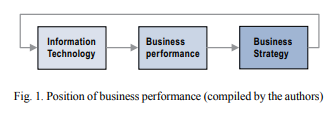
Figure-1: IS system in an organisation
(Source- Awais, Irfan, Bidal & Samin, 2012)
Continuous development and improvement of the technology has resulted in improved performance of the software and hardware. They have also lowered the cost of operation by using the information system strategy for most businesses. It has made the organisations more self-dependent and more reliant. Now these organisations are able to perform more efficiently and smoothly and gain success in a short period of time. Figure 1 shows the interdependence and the interrelation of Information Technology with business performance and business strategies all are related with one another. In the last few years it has been seen that information system strategy in a company requires lot of investment in terms of money, the big companies and enterprises are not keeping away from it (Kiedrowicz & Stanik, 2018). They have understood the various benefits that a good information system strategy provides. Therefore instead of saving money and taking a step back, every company to gain competitive advantages are improving the information system and buildings from it network. In this study we will be dealing with the information system strategy in organisations and how they influence the organisational performance.
What are the types of information system strategy?
At first it is important to understand the definition of information system. Information system can be elaborated as a given set of components that assist in the collecting process. It helps to collect data and important information. It also helps in sharing the collected data with the help of various hardware, software and firmware. This kind of systems is the fundamental Network and principles for any kind of economic development in the business. Many scholarship put forward different definitions of information system. Technology is a platform where human activities and business process takes place. Also information system strategy can be elaborated to understand the interaction between the algorithm in process Technology, information and their uses (Paliulis &Uturyt?-Vrubliauskien?, 2012). Also information system could be understood as a language that enables us to improve the decision making process of an organisation. The proper information system helps in improving the performance and decision making skills of an organisation. There can be different types of information system strategy and each is having their own functions. Their efficiency, speed, contribution towards organisation is different. Information system and advancement of information technology has helped in the disruptive innovation and building disruptive business models. Through IT advancement, innovation is brought in product, service, design and so on.
Also their cost in budget is different (Paliulis, Ma?iulyt?-Šniukien? &Vizbaras, 2012). The information systems are office information system, transaction processing system, management information system, decision support system, executive support system. All the different types of information system assist the organisation in different ways. All these information systems are also connected with one another. Executive support system receives and manages information from the MIS or management information system.There are various types of technological change like architectural change where the components are realigned with the system, incremental innovation where the products are modified and improved and so on.
Decision support system uses data of management information system and transaction processing system. It can be understood that all the information systems are connected with one another and one cannot really work without the other. The figure given below shows the different types of information system strategy and how they are connected with one another the arrow shows the information is received from one system to the other system. Together they complete a concrete information system that is used in an organisation. Each of these models have different functions. The transactional process is data about transaction of data and money. The office information system gives details of the information office (Pabedinskait?, 2010). Management information system pertains to Management Solutions and decision support system, executive support system help in the decision making and executive part of the organisation. It can be seen that a single information system helps to bind all the different organs of an organisation and it strong connection between all the organisations. It helps in smooth performance of the organisations and error-free performance. The office information system helps in the processes of Business and communication between users easier. Using computers and other devices, employees for most of their types automatically rather than manual processes. This is done by office information system strategy.
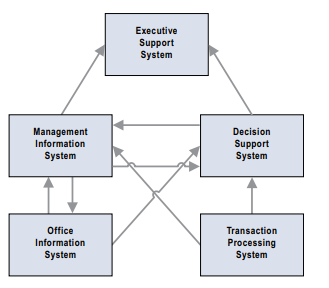
Figure-2: Types of IS system
(Source- Awais, Irfan, Bidal Samin, 2012)
The transaction processing system helps to collect and store the information throughout the day on everyday transactions (Pabedinskait?, 2009). This system answers the routine questions of a day. The management information system provides information related to processing, collecting and storing and transferring of the important business information. It is mainly used for the managers in the various operations and activities of the organisations. The management information system strategy is time bound and helps in providing timely information to the managers. This assists in decision making process to the managers and helps them to plan control an efficient performance of the operations. The decision support system helps to analyse the information for managers and the top officials. They use a decision support system to analyse all the data that has been collected (Kiedrowicz & Stanik, 2018). Finally the executive support system has information that is related to reporting software. It transforms business data and information into various summarise reports. This report that mainly used by the executive department of the company for long term scheduling and planning. To understand the operations of information system strategy we can look into an enterprise resource planning system which will help us to understand these applications in a better way. Various emerging technologies of IT are -
- Cloud computing/ASPs
- Web 2.0
- SCM
Enterprise Resource Planning (ERP) system
The enterprise resource planning is considered to be the best form of information technology that is used in business solutions. The main function of ERP or enterprise resource planning is to process information and various transaction of the organisation. It also helps to analyse the integrated production, planning as well as feedbacks of the customers. An Enterprise resource planning system is mainly created to combine all the operating systems of all the departments of the company. Thus, it is mainly integrated programme of all the databases that runs in the organisation. So that one organ can freely share information with another organ and they can't communicate freely with each other. The main function of this is to assist in good and efficient communication process (Kiedrowicz & Stanik, 2018). Every organisation has their own Optimisation information system strategy and resources that they integrate to a given enterprise resource planning system. Proper integration is very necessary for efficient communication between all the organs. In this way, tangible benefits increased and the tangible costs are reduced.
Various departments and models like finance, Human Resource Management Accounting for management of quality, marketing and sales department. Different modules ERP is shown in the figure-3 that is given below. Here we can find that the database server application server and web server are connected to the production management process in management HR finance quality marketing planning and inventory management system (Lipaj & Davidavi?ien?, 2013). It helps to prevent any kind of misunderstanding between the various organs of the organisation. The first level is a network level. This level is mainly responsible for the flowing of internal and external information of the company.
If internal and external information smoothly flow from one organ to another organ, the infrastructure of the system will be efficient. The next level is resource level and this level store all the hardware software and data required for proper functioning of ERP. It has stored applications, data bases and Web Services. These systems are used mainly by the managers to analyse the various enterprise resource planning (Craig, Habermas, Bahtin, Konetskaya, Pocheptsov & Yakovlev, 2016).
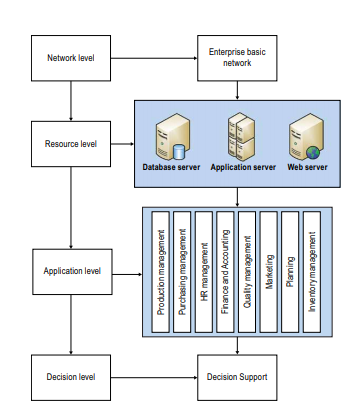
Figure-3: ERP system
(Source- Beckford, 2019)
Managers can make decisions based on information that is received from various organs of the information system strategy does not a single organ is neglected. If a system was not available, it would have been a hectic and time killing task to evaluate information from all the organs and then analyse. Thus, it helps in time management. Ordinary workers also then access to the required information (Craig, Habermas, Bahtin, Konetskaya, Pocheptsov & Yakovlev, 2016). This is also helps in the delegation of authority for better interaction with the production units and the customers. Also has been seen that by implement in incorporating the systems into the operations of the company, the company attained competitive advantage in the market. It has been seen that better the company and larger the organisation, they spend more amount of money in strengthening there IS system. Various companies have millions of money invested in their ERP system to remain at the number one spot in the market. A barrier in the process is that many people implement IT processes in a half hearted manner that creates problems.
Business performance through ERP implementation
It has been understood in the past few decades that the implementation of ERP system and strengthening the system of an organisation can help in improve the productivity and also increase efficiency of the organisation. Improvement in performance can be attained by different ways. This could be easily visible in a few days or can be evaluated. At times this system implementation and its effect are long term. Also it has been seen that a company is getting result after a long run. Numerous competitive advantages result from a strong IS systems and implementation of ERP in their organisation. It also helps in reducing the cost of business, assist in quick responses to the customers and also enhances corporate connection. In simple term it simplifies the work processes and also cuts the time required to perform various activities. It has eased the processes of corporate life (Hussein & Hafseld, 2016).
Also it increases the validity and also the security of data. Along with this it has been understood that it also reduces the work processes of the secretariat department. It also helps to improve and implement the sales value of the output and the turnover rate of the inventory is made lower. It is also seen that all these processes has improved the activities and operations of a company. The budget of the company is also influenced by all this. Though, the company need to spend use amount of money for creating this kind of information system strategy, but this kind of information systems doubles the revenue of the company. The time taken by a company to complete a project is reduced to half by using this kind of information system strategy as a result of which the company managers to take out new projects at a good rate. Also increases the market share of a company and helps to minimise the marginal cost and above all it increases the satisfaction of the customers.
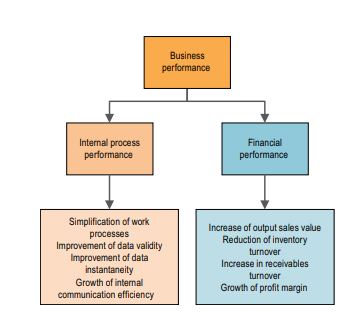
Figure-4: Business performance improvement
(Source- Beckford, 2019)
The business performance can be measured from two different perspectives. In internal process performance it has been noted that the system has helped in simplification of processes, it has helped to improve the validity of the data. All the data stored is now safe and secure. There can be a password protected and can be kept away from other people like intruders. Thus, any kind of data can be prevented from being foged (Olaoye, Akinleye, Olaoye & Obasesin, 2019). Various secure data can be specially protected to restrict the access of intruders. Also, an internal communication system has become more efficient and it has grown. Thus, it has improved and evolved the overall internal process performance of an organisation. Another way we can measure the business performance is financial performance of a company. It has been found that after implementation, increase the output sales value and also reduce the turnover of inventory. Along with the profit margin growth, the receivables turnover is also increases. Figure-4 shows a detail of improvement and enhancement of the business performance of an organisation after successful implementation incorporated a system into their business process.
The system has been understood to improve the information flow between the various units of business. Improvement in the coordination and cooperation among the employees has been noticed. Information system strategy helps to reduce the cost of maintenance of information (Hussein & Hafseld, 2016). It helps to reduce inventory and also reduction in indirect labour. It also assists in lean Management by increasing profit and reducing waste. Only the important information from the pool of data is collected. Thus, it helps to minimise the waste that is generated. Paperwork is reduced and management is performed in an efficient way. Service is performed in a better way as all the details and data along with information is stored in an integrated version of database. It information system strategy can be developed is a number of ways. An illustration is given below.
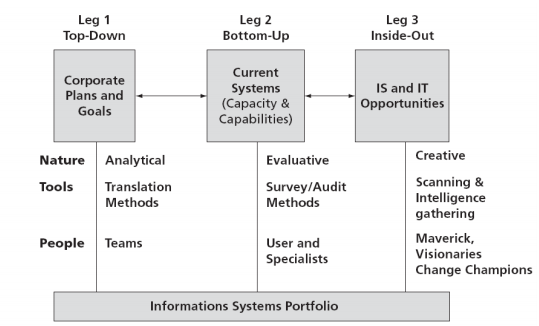
Figure-5: Developing IT strategy
(Source- Pabedinskait?, 2010)
Conclusion
Based on the above analysis and understanding of the information system strategy and its impact on organisations performance, we can conclude a few important points. The increase in demand and need for information in present day requires a development of good information system strategy in every organisation. Every organisation need to follow the latest trends and news on Information Technology Solutions. it will help them to evolve their business and make it more efficient. Thus, it will give them competitive advantage over their others. It helps in improving the goals and targets along its strategies. As the number of companies that increasing every day, investment of money into information system strategy is also increasing. But the company to invest in more also getting better benefits in production process of finance and accounting, customer service in various information process involving and getting improve the use of good information system.
References
Awais, M.; Irfan, M.; Bidal, M.; Samin, T. 2012. Helpful Business Value of Advance Bal Information System, IJCSI International Journal of Computer Science Issues 9(2): 415–422. ISSN 1694-0814.
Beckford, J., 2019. The Intelligent Organisation: Driving Systemic Change with Information. Information system strategy Routledge.
Craig, R.T., Habermas, Y., Bahtin, ?.?., Konetskaya, V.P., Pocheptsov, G. & Yakovlev, I.P., 2016. COMMUNICATION PROCESS IN THE SYSTEM OF ORGANISATION MANAGEMENT. ?????????? ???????, p.126.
Hussein, B.A. & Hafseld, K.H., 2016. Organisational influences impacting user involvement in a major information system project: a case study in a governmental organisation. International Journal of Project Organisation and Management, 8(1), pp.24-43.
Kiedrowicz, M. & Stanik, J., 2018. An information system risk model for the risk management system of an organisation processing sensitive data. Zarz?dzanie i Finanse, 16(3, cz. 1), pp.207-227.
Lipaj, D. & Davidavi?ien?, V., 2013. Influence of information systems on business performance/Informacini? sistem? ?taka ?mon?s veiklos rezultatams. Mokslas–Lietuvos ateitis/Science–Future of Lithuania, 5(1), pp.38-45.
Olaoye, C.O., Akinleye, G.T., Olaoye, F.O. & Obasesin, M.O., 2019. THE SIGNIFICANCE OF ACCOUNTING SYSTEM ON PERFORMANCE OF NON PROFIT ORGANISATION IN NIGERIA. Academic Journal of Current Research, 6(10).
Pabedinskait?, A. 2009. Successful implementation of ERP Systems, in The 9th international conference “Liberec Economic Forum 2009”, 15–16 September 2009. Liberec, Czech Republic. Liberec, 275–283. ISBN 9788073725235.
Pabedinskait?, A. 2010. Factors of successful implementation of ERP systems, Ekonomika ir vadyba 15: 691–697. Interneto prieiga: http://www.ktu.lt/lt/mokslas/zurnalai/ekovad/15/1822-6515-2010-691.pdf. ISSN 1822-6515.
Paliulis, N. K.; Ma?iulyt?-Šniukien?, A.; Vizbaras, A. 2012 . Informacin?s visuomen?s pl?tros ir jos ?takos darbo produktyvumui vertinimas: Lietuva Europos S?jungos šali? kontekste, Ekonomika ir vadyba: aktualijos ir perspektyvos 2(26): 17–32. ISSN 1648-9098.
Paliulis, N. K.; Uturyt?-Vrubliauskien?, L. 2012. Performance measurement system to evaluate the efficiency of e-business, in The 7th international scientific conference “Business and Management 2012”: selected papers. May 10–11, 2012. Vol. 1: 895–903. Information system strategy ISSN 2029-4441. Prieiga per internet?: http://leidykla.vgtu.lt/conferences/BM_2012/information_and_communication/895_903_Paliulis.pdf.












